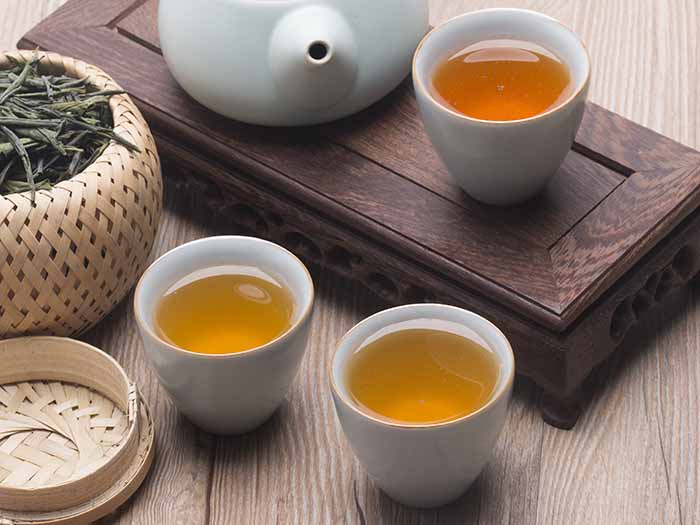If you have always wondered about the green tea that is offered at Japanese sushi-style bars and restaurants, it is called agari. Sushi has a briny flavor, so you do tend to feel thirsty while savoring those delicious mouthfuls. Agari offers the right amount of flavor that complements sushi. Let’s learn more about this green tea.
Agari: Green Tea That Pairs Well With Sushi
Agari or konacha is the traditional green tea at most Japanese sushi restaurants as part of the sushi eating experience. It is usually not on the menu and is served free of cost. The tea is made from green tea powder called konacha. The green tea powder comprises the rejected buds, tiny leaves, and the tea ‘dust’, a natural byproduct, from the processing of gyokuro or sencha tea leaves. This is why the konacha is less expensive than tea leaves. [1]

A light-tasting green tea is usually served with sushi. Photo Credit: Shutterstock
The light, fresh-tasting agari complements the complex, multi-layered flavors of sushi and sashimi. Because it is made from tea powder, it can be brewed in 30 to 60 seconds and needs to be strained with a fine mesh strainer. It is served unusually hot. The clean-tasting beverage helps cleanse the palate and wash off the fish oils. You can choose to have your cup between bites of sushi or enjoy it after your meal!
In Japan, tea connoisseurs search for high-quality Konacha, which are made from only the highest quality gyokuro or sencha leaves. This is in limited supply as the tea powder accounts for only 10 percent of all tea leaves.
When Should You Ask For Agari?
If you have not been served agari, you can always ask for it. You will be appreciated for the knowledge you have of the Japanese culture. Some people like to have tea while taking breaks between trying different sushi and sashimi whereas some prefer to have it the end of their sushi meal.
Other Teas You Can Have With Sushi
You can enjoy other green teas with sushi too. However, they may not be free of charge. Here are the best tasting and most popular varieties of Japanese green tea which can be enjoyed with sushi.
- Gyokuro: This tea is one of the highest grades of tea from Japan and may come with an expensive price tag. It is made from very deep green tea leaves and has a mellow flavor.
- Sencha: Since this variety of green tea has a grassy, sweet taste, it is best to have this post your sushi meal. It is a light, refreshing beverage.
- Kukicha: This green tea, made from the twigs of the green tea plant, has a creamy and nutty flavor. It is a lovely tea to end your sushi meal with.
- Genmaicha: Green tea leaves are mixed with roasted rice to make this wonderful Japanese tea. This light yellow-hued tea is light enough to have between your sushi meals or to round up a light meal.
- Matcha: This beautiful green-hued tea is a wonderful, rich way to end your meal. If you want to take it a step further, you can opt for matcha-flavored desserts.
You may have a different experience when you eat at a Chinese restaurant as they offer jasmine tea, a green tea scented with jasmine flowers. In many western restaurants, you may see that sushi is paired with sake, a traditional Japanese alcoholic beverage made by fermenting rice. This is not a traditional pairing as sushi also has rice. If you do want to opt for alcohol, white wines like a refreshing Reisling or a light red wine like a Pinot Noir are good options. Japanese fruit wines and beers also work well.
But you may find, like the most traditional pairings, that agari is one of the best options to sip on while enjoying your sushi!
